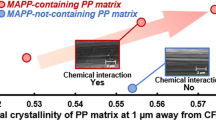Abstract
The influence of matrix modification on the interfacial shear strength (IFSS) and the mechanical performance of polypropylene/glass fibre composites is investigated. Two different modifiers were used: a highly reactive hyperbranched polymer grafted polypropylene (HBPgPP) and a maleic anhydride grafted polypropylene (MAHgPP). The interfacial shear strength increased with the addition of the modifiers, with HBPgPP giving the highest values. To evaluate the effects of the matrix modification on the composite strength, a method to normalise the composite strength with respect to fibre orientation and fibre concentration is presented. The normalised strength values followed the same trend as the measured IFSS values, namely that the HBPgPP modified composite displayed the highest strength and the unmodified material the lowest.
Similar content being viewed by others
References
Karger-Kocsis, J., Polypropylene: Structure, Blends and Composites: Composites, Chapman and Hall, London, 1995.
Mäder, E., Jacobasch, H.-J., Grundke, K., and Gietzelt, T., 'Influence of an Optimized Interphase on the Properties of Polypropylene/Glass Fibre Composites', Compos. Part A-Appl. S. 27A, 1996, 907–912.
Thompson, M. R., Tzoganakis, C., and Rempel, G. L., 'Terminal Functionalisation of Polypropylene via the Alder ene Reaction', Polymer 39, 1998, 327–334.
Peltonen, P., Pääkkönen, E. J., Järvelä, P. K., and Törmälä, P., 'The Influence of Adhesion Promoters on the Properties of Injection Moulded Long-glass-fibre Polypropylene', Plast. Rubb. Comp. Proc. Appl. 23, 1995, 111–126.
Cameron, R. and Constable, R. C., 'The Use of Chemical Coupling Agents in Glass Reinforced Polyolefins', Polym. and Polym. Comp. 1, 1993, 45–52.
Constable, R. C., 'Evaluation of Chemically Modified Polypropylene with Various Glass Fiber Types, for Performance Enhancement in Glass Filled Polypropylene', in Proceedings of ANTEC '94, 1994, pp. 1549–1552.
Cantwell, W. J., Tato, W., and Kausch, H. H., 'The Influence of a Fiber-Matrix Coupling Agent on the Properties of a Glass Fiber/Polypropylene GMT', J. Thermoplast Comp. 4, 1992, 304–317.
Sathe, S. N., Rao, G. S. S., and Devi, S., 'Grafting of Maleic Anhydride onto Polypropylene: Synthesis and Characterization', J. Appl. Polym. Sci. 53, 1994, 239–245.
Schmitt, M. W., Untersuchungen zum Funktionalisieren von Polyolefinen, PhD Thesis, Technischen Hochschule Darmstadt, Germany, 1996.
Constable, R. C. and Amur, A. M., 'Chemical Coupling of Glass-Filled Polypropylene Using Acid or AnhydrideModified Polypropylenes', in Proceedings of ANTEC, 1991, pp. 1892–1896.
Hojabr, S. and Boocock, J. R. B., 'Enhancement of Filled Polyolefin's Properties by Addition of Polymeric Coupling Agents', in Proceedings of ANTEC, 1995, pp. 3620–3627.
Duvall, J., Sellitti, C., Myers, C., Hiltner, A., and Bauer, E., 'Interfacial Effects Produced by Crystallization of Polypropylene with Polypropylene-g-Maleic Anydride Compatibilisers', J. Appl. Polym. Sci. 52, 1994, 207–216.
Jannerfeldt, G., Boogh, L., and Månson, J. A.-E., 'Tailored Interfacial Properties for Immiscible Polymers by Hyperbranched Polymers', to be published.
Bigg, D. M., Hiscock, D. F., Preston, J. R., and Bradbury, E. J., 'The Properties of Wet-formed Thermoplastic Sheet Composites', Polym. Comp. 14, 1993, 26–34.
Thomason, J. L. and Vlug, M. A., 'Influence of Fiber Length and Concentration on the Properties of Glass Fibre-Reinforced Polypropylene: 4. Impact Properties', Compos. Part A-Appl. S. 28A, 1997, 277–288.
Hull, D. and Clyne, T. W., An Introduction to Composite Materials, 2nd edn, Cambridge University Press, 1996.
Kelly, A. and Tyson, W. R., 'Tensile Properties of Fibre-reinforced Metals: Copper/Tungsten and Copper/Molybdenum', J. Mech. Phys. Solids 13, 1965, 329–350.
Gupta, V. B., Mittal, R. K., and Sharma, P. K., 'Some Studies on Glass Fiber-Reinforced Polypropylene. Part II: Mechanical Properties and Their Dependence on Fiber Length, Interfacial Adhesion, and Fiber Dispersion', Polym. Composite 10, 1989, 16–27.
Herrera-Franco, P. J. and Drzal, L. T., 'Comparison of Methods for the Measurement of Fibre/Matrix Adhesion in Composites', Composites 23, 1991, 2–27.
Swedish Standard, No. EN 25 663.
Jannerfeldt, G., Boogh, L., and Månson, J.-A. E., 'The Influence of Hyperbranched Polymers on the Interfacial Tension of Polypropylene/Polyamide 6 Blends', J. Polym. Sci. Pol. Phys. 37, 1999, 2069.
Moon, C.-K., 'The Effect of Interfacial Microstructure on the Interfacial Strength of Glass Fiber/Polypropylene Resin Composites', J. Appl. Polym. Sci. 54, 1994, 73–82.
Author information
Authors and Affiliations
Rights and permissions
About this article
Cite this article
Jannerfeldt, G., Törnqvist, R., Rambert, N. et al. Matrix Modification for Improved Reinforcement Effectiveness in Polypropylene/Glass Fibre Composites. Applied Composite Materials 8, 327–341 (2001). https://doi.org/10.1023/A:1011256300651
Issue Date:
DOI: https://doi.org/10.1023/A:1011256300651




